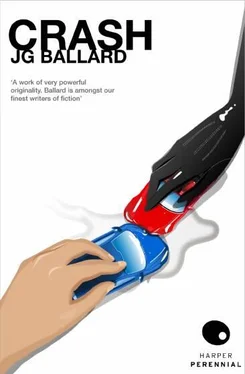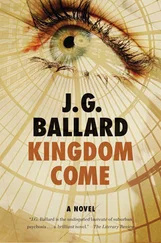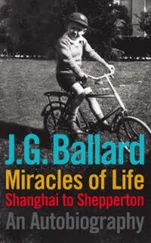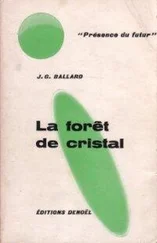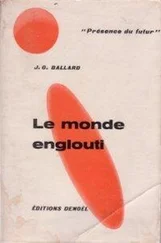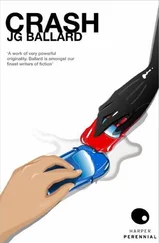The leitmotiv of this photographic record emerged as I recovered from my injuries: my relationships, mediated by the automobile and its technological landscape, with my wife, Renata and Dr Helen Remington. In these crude photographs, Vaughan had frozen my uncertain embraces as I edged my wounded body into its first sexual encounters since the accident. He had caught my hand stretching across the transmission tunnel of my wife’s sports car, the inner surface of my forearm dented by the chromium gear lever, my bruised wrist pressing against the white flank of her thigh; my still-numb mouth against Renata’s left nipple, lifting her breast from her blouse as my hair fell across the window-sill; Helen Remington sitting astride me in the passenger seat of her black saloon, skirt hitched around her waist, scarred knees pressing against the vinyl seat as my penis entered her vulva, the oblique angle of the instrument panel forming a series of blurred ellipses like globes ascending from our happy loins.
Vaughan stood at my shoulder, like an instructor ready to help a promising pupil. As I stared down at the photograph of myself at Renata’s breast, Vaughan leaned across me, his real attention elsewhere. With a broken thumbnail, its rim caked with engine oil, he pointed to the chromium window-sill and its junction with the overstretched strap of the young woman’s brassiere. By some freak of photography these two formed a sling of metal and nylon from which the distorted nipple seemed to extrude itself into my mouth.
Vaughan’s face was without expression. Childhood boils had left an archipelago of pockmarks across his neck. A sharp but not unpleasant smell rose from his white jeans, a blend of semen and engine coolant. He turned through the photographs, now and then tilting the album to emphasize an unusual camera angle for me.
I watched Vaughan close the album, wondering why I was unable to rouse myself into at least a parade of anger, remonstrate with him for this intrusion into my life. But Vaughan’s detachment from any emotion or concern had already had its effect. Perhaps some latent homo-erotic element had been brought to the surface of my mind by his photographs of violence and sexuality. The deformed body of the crippled young woman, like the deformed bodies of the crashed automobiles, revealed the possibilities of an entirely new sexuality. Vaughan had articulated my needs for some positive response to my crash.
I looked down at Vaughan’s long thighs and hard buttocks. However carnal an act of sodomy with Vaughan would have seemed, the erotic dimension was absent. Yet this absence made a sexual act with Vaughan entirely possible. The placing of my penis in his rectum as we lay together in the rear seat of his car would be an event as stylized and abstracted as those recorded in Vaughan’s photographs.
The television director came hazily to the door, a wet cigarette unravelling between his fingers.
‘V.—can you fix this? Seagrave messed it up.’ He drew emptily on a crack on the side of the cigarette, and nodded to me. ‘The nerve centre, eh? Vaughan makes everything look like a crime.’
Vaughan put down the camera tripod he was oiling and expertly tucked the tobacco into the cigarette, pouring back the grains of hash that landed on his palm. He licked the paper with a sharp tongue that darted from his scarred mouth like a reptile’s. His nostrils sucked at the smoke.
I looked through a batch of freshly developed prints on the table below the window. They showed the familiar face of the film actress, photographed as she was stepping from her limousine outside a London hotel.
‘Elizabeth Taylor—are you following her?’
‘Not yet. I need to meet her, Ballard.’
‘As part of your project? I doubt if she’ll be able to help you.’
Vaughan sauntered around the room on his uneven legs.
‘She’s working at Shepperton now. Aren’t you using her in a Ford commercial?’
Vaughan waited for me to speak. I knew that he would act on any evasion. Thinking of Seagrave’s grim concussion-fantasy—the film stars forced to crash their own stunt-cars—I decided not to answer.
Seeing all this cross my face, Vaughan turned to the door. ‘I’ll call Dr Remington for you—we’ll talk about this again, Ballard.’
He handed to me, presumably as a pacifier, a bundle of well-thumbed Danish sex magazines. ‘Have a look at these—they’re more professionally done. You and Dr Remington might enjoy them together.’
Gabrielle, Vera Seagrave and Helen were in the garden, their voices drowned by the blare of aircraft taking off from the airport. Gabrielle walked in the centre, her shackled legs in a parody of a finishing-school carriage. Her pallid skin reflected the amber street-lights. Helen held her left elbow, steering her gently through the knee-high grass. It suddenly occurred to me that during all the time I had spent with Helen Remington I had never discussed her dead husband with her.
I looked through the colour photographs in the magazines; in all of them the motor-car in one style or another figured as the centrepiece—pleasant images of young couples in group intercourse around an American convertible parked in a placid meadow; a middle-aged businessman naked with his secretary in the rear seat of his Mercedes; homosexuals undressing each other at a roadside picnic; teenagers in an orgy of motorized sex on a two-tier vehicle transporter, moving in and out of the lashed-down cars; and throughout these pages the gleam of instrument panels and window louvres, the sheen on over-polished vinyl reflecting the soft belly of a stomach or a thigh, the forests of pubic hair that grew from every corner of these motor-car compartments.
Vaughan watched me from the yellow armchair as Seagrave played with his small son. I remember his face, detached but serious, as Seagrave unbuttoned his shirt and placed the child’s mouth on his nipple, squeezing the hard skin into the parody of a breast.
My meeting with Vaughan, and the album of photographs documenting my accident, had quickened all my memories of that trauma of dreams. Going down to the basement garage a week later, I found myself unable to point the car in the direction of the studios at Shepper-ton, almost as if the vehicle had been transformed during the night into a Japanese uni-directional toy, or fitted like my own head with a powerful gyroscope that pointed only towards the foot of the airport flyover.
Waiting for Catherine to leave for her flying lesson, I drove my car towards the motorway, and within a few minutes had trapped myself in a traffic jam. The lines of stalled vehicles reached to the horizon, where they joined the clogged causeways of the motor routes to the west and ‘south of London. As I edged forward, my own apartment house came into sight. Above the rails of the sitting-room balcony I could actually see Catherine moving about on some complex errand, making two or three telephone calls and scribbling away on a pad. In an unexpected way she seemed to be playing at being myself—already I knew that I would be back in the apartment the moment she left, taking up my convalescent position on that exposed balcony. For the first time I realized that sitting there, halfway up that empty apartment face, I had been visible to tens of thousands of waiting motorists, many of whom must have speculated about the identity of this bandaged figure. In their eyes I must have appeared like some kind of nightmarish totem, a domestic idiot suffering from the irreversible brain damage of a motorway accident and now put out each morning to view the scene of his own cerebral death.
The traffic stirred slowly towards the Western Avenue interchange. I lost sight of Catherine as the glass curtain-walling of the high-rise apartment blocks moved between us. Around me the morning traffic lay in the fly-infested sunlight. Strangely, I felt almost no sense of anxiety. That profound feeling of foreboding, which had hung like the overhead traffic lights over my previous excursions along the motorways, had now faded. Vaughan’s presence, somewhere around me on these crowded causeways, convinced me that some kind of key could be found to this coming autogeddon. His photographs of sexual acts, of sections of automobile radiator grilles and instrument panels, conjunctions between elbow and chromium window-sill, vulva and instrument binnacle, summed up the possibilities of a new logic created by these multiplying artefacts, the codes of a new marriage of sensation and possibility.
Читать дальше
Конец ознакомительного отрывка
Купить книгу
